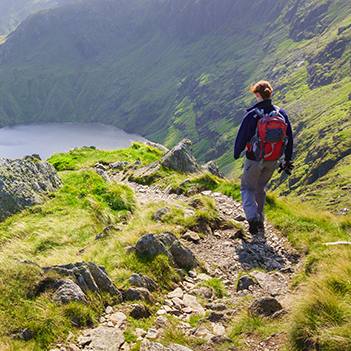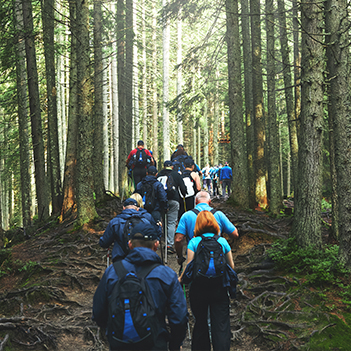Dorset Doddle historic article
(Written in late 2005 and published in the August 2007 edition of Dorset Life)
It's no doddle
MA. Rodger introduces us to the challenge and satisfaction of the Dorsets' Doddle
An August Sunday at 6.15 am and a lone figure stations himself at the entrance to an empty car park in Swanage. The sun has just risen but the sky is blanketed by thick grey cloud. It is cold. Not a soul is in sight. The lone figure checks his mobile phone to pass the time. Thankfully, no messages. No news is good news today - everything going to plan.
He is awaiting the arrival of the first entrants for the Dorsets' Doddle. The coaches to whisk them off to Weymouth will not turn up until 7.00 am but, with some entrants coming from as far away as Cheshire and staying overnight locally, many will arrive well before the coaches. The lone figure, one of twenty or so event marshals, has volunteered to be the welcoming committee for the early arrivers who start to appear by 6.30 am.
The Dorsets' Doddle is a challenge walk. The challenge is to walk from Weymouth to Swanage along Dorset's glorious coast path within twelve hours. There is some dispute as to the length of the route. Some say it is 33 miles. some that it is just 29 miles. However, more important to walkers than the mileage and not open to any dispute are all the hilts - over 6000 feet of climbs. That is over a mile up and a mite down, making the exact horizontal distance rather academic.
By shortly before 9.00 am, all the entrants are beginning to gather beneath the Jubilee Clock on Weymouth sea-front. Onlookers, out to buy a paper or walk the dog, are not sure why the Esplanade is so crowded, what the event is. It isn't obvious as many of the entrants are dressed in running gear, only a bum-bag and water bottle indicating that this isn't a hundred-metre sprint. Others have substantial backpacks and heavy walking boots. Also gathered around are friends and supporters not entered in the event.
Some entrants know the route well. Others apprehensively study the three-page route description handed out when they registered with the start marshals. Keeping on the coast path .is not as easy as it could be. Signposts along the route are lacking in places and the cheerful advice, 'Keep the sea on your right', is less than helpful. One not uncommon mistake is to descend to the Fossil Forest and Mupe Bay beyond Lulworth, only to discover that you have to climb up to the summit of Bindon Hill for a second time.
Over the years coastal erosion has forced the coast path to be re-routed a number of times. The route is now checked a week or two ahead of the event and amendments made to the directions where necessary. In 2006 a diversion appeared at Kimmeridge two weeks before the event as work had started to rescue the Clavell Tower and move it back from the cliff-edge.
At 9.00 am, after a few words from the chief steward, words that most cannot hear, the crowd surges off along the Esplanade. Some set off at a cracking pace, running or walking. Others are in less of a hurry. Its a long way to Swanage.
The Dorset Doddle was first staged in 1980, the first year walkers were allowed through the army ranges and a time when few such challenge walks existed. Today challenge walks are far more common, with almost two hundred such walks per year around the country. The Doddle remains popular, however, with many contestants returning year after year. Last year saw 204 entrants.
By midday the walkers are arriving at Lulworth Cove in twos and threes, weaving their way amongst the tourists down the path from the hill above Durdle Door. Lulworth is a major breakpoint on the Doddle, three miles short of halfway. Walkers usually stop for a few minutes to eat their sandwiches, bananas or energy bars. Bindon Hill and Flowers Barrow are the next two hills and both are big. Other walkers stop only to refill water bottles. It is still cloudy, with a cooling westerly breeze at their backs but a few spots of rain raise alarm because beyond Kimmeridge, the path easily turns to slippery mud when rain sets in.
The Dorset Doddle was originally organised by Bournemouth Council's Youth Services. Along with a shorter circular event called the Purbeck Plod, it was intended to encourage youth clubs to get out walking in the countryside. The secret ingredient was the lift back to the finish if the going got too tough, available from the many checkpoints along the route. Yet from the first, most entrants were adult, almost exclusively so these days.
When council reforms stopped Bournemouth Youth Services organising the Doddle, an ex-employee, Les Griffiths, took over running the ever-popular event. Any proceeds from the event were donated to youth projects. The Doddle eventually lapsed in 2003 with Les's failing health, only to be re-started in 2004 due to popular demand and organised by the Dorsets, the local branch of the Long Distance Walkers Association. 'People began asking why we weren't running the Doddle: says Bill Peach, the Dorsets' Walks Secretary. They kept insisting it was our job, even though we had our hands full organising other Dorset challenge walks. Eventually we gave in to sustained pressure.
6.30 pm at Chapman's Pool and the marshals sweeping the route are approaching the checkpoint on Emmetts Hill close by the Royal Marines memorial. The sun had broken through the clouds by mid-afternoon and now the shadows are lengthening. The coast looks magical as the light begins to redden. The weather has been kind. Past years have seen the Doddle staged on the hottest day of the year with temperatures up in the high eighties. It has also been staged in monsoons with over an inch of rain. Now the weather is perfect for the entrants, although the breeze is decidedly chilly for marshals standing for hours manning the checkpoints.
The last few walkers on Emmetts Hill decide twenty-four miles is far enough for today and relax to enjoy' he Dorset coast under the evening sun. After a short pause, the sweepers collect the checkpoint tally sheets and stride off towards the last checkpoint at Anvil Point.
While just completing the Dorsets' Doddle is challenging enough some entrants run the route, although if you press them they do admit to not running up all the hills. The first finisher last year arrived at 2.24 pm - not quite a record. It is said that one year the first finisher promptly ran back to Kimmeridge to meet up with his wife, who was also running in the event, and accompanied her for the last third of the course back to Swanage. Such tall tales are common on established challenge walks.
Originally the Doddle finished at the clock tower on Swanage sea front but practicality dictated the need for more facilities for tired walkers. Now the finish is All Saints Church Hall. It is 9.20 pm, pitch-black night, as the last walker arrives, escorted by a sweeper. He is walking for charity so was determined to complete the course and is well catered for, even though the last of the other 165 finishers have already had their hot meal and set off for home. It has been a long day, both for entrants and for organisers.
The name has changed slightly under its new management - from The Dorset Doddle' to 'The Dorsets' Doddle' - but the irony of the name lives on unchanged. Be they first-time finishers or seasoned entrants who complete the Doddle year after year, all participants agree with the words of Les Griffiths: 'It doesn't matter how fit you are, it's no doddle.
[This year's Doddle is on 19 August 2007. For full information and an entry form go to www.ldwa.org.uk/Dorset. Would-be entrants are reminded of the demanding nature of the event.]
Text of article in Dorset Life No 341 August 2007, pp44-46.





